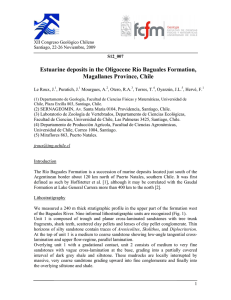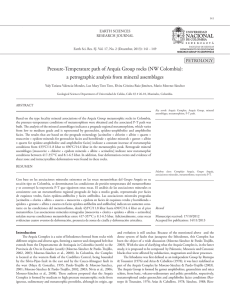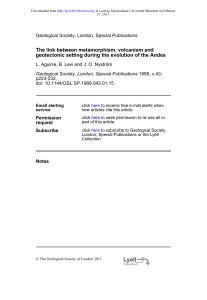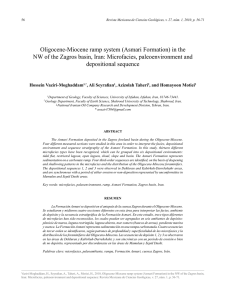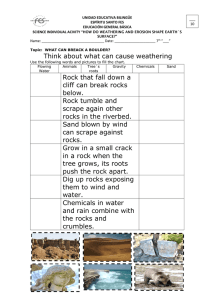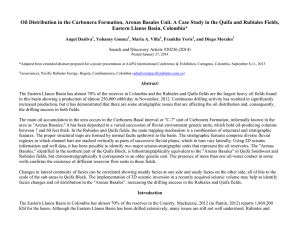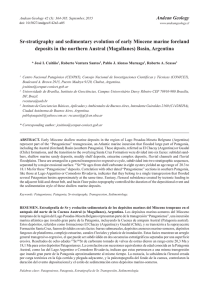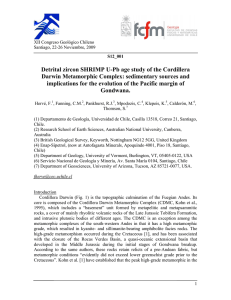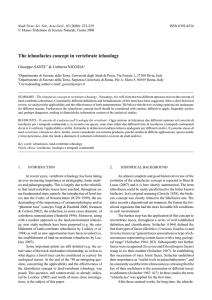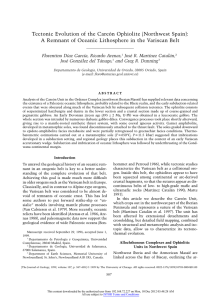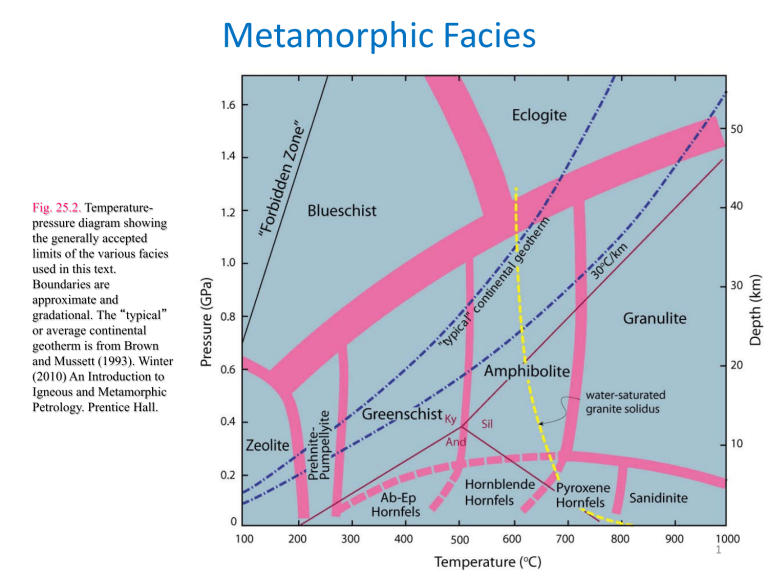
Metamorphic Facies Fig. 25.2. Temperaturepressure diagram showing the generally accepted limits of the various facies used in this text. Boundaries are approximate and gradational. The “typical” or average continental geotherm is from Brown and Mussett (1993). Winter (2010) An Introduction to Igneous and Metamorphic Petrology. Prentice Hall. 1 Metamorphic Facies Table 25.1. The definitive mineral assemblages that characterize each facies (for mafic rocks). Table 25-1. Definitive Mineral Assemblages of Metamorphic Facies Facies Zeolite Definitive Mineral Assemblage in Mafic Rocks zeolites: especially laumontite, wairakite, analcime Prehnite-Pumpellyite prehnite + pumpellyite (+ chlorite + albite) Greenschist chlorite + albite + epidote (or zoisite) + quartz ± actinolite Amphibolite hornblende + plagioclase (oligoclase-andesine) ± garnet Granulite orthopyroxene (+ clinopyrixene + plagioclase ± garnet ± hornblende) Blueschist glaucophane + lawsonite or epidote (+albite ± chlorite) Eclogite pyrope garnet + omphacitic pyroxene (± kyanite) Contact Facies After Spear (1993) Mineral assemblages in mafic rocks of the facies of contact metamorphism do not differ substantially from that of the corresponding regional facies at higher pressure. 2 It is convenient to consider metamorphic facies in 4 groups: 1) Facies of high pressure • The blueschist and eclogite facies: low molar volume phases under conditions of high pressure • Blueschist facies- areas of low T/P gradients: subduction zones • Eclogites: stable under normal geothermal conditions Deep crustal chambers or dikes, sub-crustal magmatic underplates, subducted crust that is redistributed into the mantle 3 Metamorphic Facies 2) Facies of medium pressure • Most exposed metamorphic rocks belong to the greenschist, amphibolite, or granulite facies • The greenschist and amphibolite facies conform to the “typical” geothermal gradient 4 Metamorphic Facies • 3) Facies of low pressure • Albite-epidote hornfels, hornblende hornfels, and pyroxene hornfels facies: contact metamorphic terranes and regional terranes with very high geothermal gradient. • Sanidinite facies is rare- limited to xenoliths in basic magmas and the innermost portions of some contact aureoles adjacent to hot basic intrusives 5 Metamorphic Facies • 4) Facies of low grades • • Rocks may fail to recrystallize thoroughly at very low grades, and equilibrium not always attained Zeolite and prehnitepumpellyite facies not always represented, and greenschist facies may be the lowest grade developed in many regional terranes 6 Metamorphic Facies Combine the concepts of isograds, zones, and facies • Examples: “chlorite zone of the greenschist facies,” the “staurolite zone of the amphibolite facies,” or the “cordierite zone of the hornblende hornfels facies,” etc. • Metamorphic maps typically include isograds that define zones and ones that define facies boundaries • Determining a facies or zone is most reliably done when several rocks of varying composition and mineralogy are available 7 Fig. 25.10. Typical mineral changes that take place in metabasic rocks during progressive metamorphism in the medium P/T facies series. The approximate location of the pelitic zones of Barrovian metamorphism are included for comparison. 8 Winter (2010) An Introduction to Igneous and Metamorphic Petrology. Prentice Hall. Facies Series A traverse up grade through a metamorphic terrane should follow one of several possible metamorphic field gradients (Fig. 21.1), and, if extensive enough, cross through a sequence of facies 9 Figure 21.1. Metamorphic field gradients (estimated P-T conditions along surface traverses directly up metamorphic grade) for several 10 metamorphic areas. After Turner (1981). Metamorphic Petrology: Mineralogical, Field, and Tectonic Aspects. McGraw-Hill. Facies Series Miyashiro (1961) proposed five facies series, most of them named for a specific representative “type locality” The series were: 1. Contact Facies Series (very low-P) 2. Buchan or Abukuma Facies Series (low-P regional) 3. Barrovian Facies Series (medium-P regional) 4. Sanbagawa Facies Series (high-P, moderate-T) 5. Franciscan Facies Series (high-P, low T) 11 Fig. 25.3. Temperaturepressure diagram showing the three major types of metamorphic facies series proposed by Miyashiro (1973, 1994). Winter (2010) An Introduction to Igneous and Metamorphic Petrology. Prentice Hall. 12 Metamorphic Facies Figure 25.4. Schematic cross-section of an island arc illustrating isotherm depression along the outer belt and elevation along the inner axis of the volcanic arc. The high P/T facies series typically develops along the outer paired belt and the medium or low P/T series develop along the inner belt, depending on subduction rate, age of arc and subducted lithosphere, etc. From Ernst (1976). 13 Metamorphism of Mafic Rocks Mineral changes and associations along T-P gradients characteristic of the three facies series • Hydration of original mafic minerals generally required • If water unavailable, mafic igneous rocks will remain largely unaffected, even as associated sediments are completely reequilibrated • Coarse-grained intrusives are the least permeable and likely to resist metamorphic changes • Tuffs and graywackes are the most susceptible 14 Metamorphism of Mafic Rocks Plagioclase: • Ca-rich plagioclase progressively unstable as T lowered • General correlation between temperature and maximum An-content of stable plagioclase Low metamorphic grades: albite (An0-3) Upper-greenschist facies oligoclase becomes stable. Andesine and more calcic plagioclase stable in the upper amphibolite and granulite facies • The excess Ca and Al → calcite, an epidote mineral, sphene, or amphibole, etc. (depending on P-T-X) 15 Metamorphism of Mafic Rocks • Clinopyroxene → various mafic minerals. • Chlorite, actinolite, hornblende, epidote, a metamorphic pyroxene, etc. • The mafics that form are commonly diagnostic of the grade and facies 16 Mafic Assemblages at Low Grades • Zeolite and prehnite-pumpellyite facies • Do not always occur - typically require unstable protolith • Boles and Coombs (1975) showed that metamorphism of tuffs in NZ accompanied by substantial chemical changes due to circulating fluids, and that these fluids played an important role in the metamorphic minerals that were stable • The classic area of burial metamorphism thus has a strong component of hydrothermal metamorphism as well 17 Mafic Assemblages of the Medium P/T Series: Greenschist, Amphibolite, and Granulite Facies • The greenschist, amphibolite and granulite facies constitute the most common facies series of regional metamorphism • The classical Barrovian series of pelitic zones and the lower-pressure Buchan-Abukuma series are variations on this trend 18 Greenschist, Amphibolite, Granulite Facies • Metamorphism of mafic rocks first evident in the greenschist facies, which correlates with the chlorite and biotite zones of associated pelitic rocks Typical minerals include chlorite, albite, actinolite, epidote, quartz, and possibly calcite, biotite, or stilpnomelane Chlorite, actinolite, and epidote impart the green color from which the mafic rocks and facies get their name 19 Greenschist, Amphibolite, Granulite Facies Greenschist → Amphibolite facies transition involves two major mineralogical changes 1. Albite → oligoclase 2. Actinolite → hornblende (amphibole accepts increasing aluminum and alkalis at higher T) Both transitions occur at approximately the same grade, but have different P/T slopes 20 Greenschist, Amphibolite, Granulite Facies Amphibolite → granulite facies ~ 650-700oC If aqueous fluid, associated pelitic and quartzofeldspathic rocks (including granitoids) begin to melt in this range at low to medium pressures → migmatites and melts may become mobilized As a result not all pelites and quartzo-feldspathic rocks reach the granulite facies 21 22 Greenschist, Amphibolite, Granulite Facies • Mafic rocks generally melt at higher temperatures • If water is removed by the earlier melts the remaining mafic rocks may become depleted in water • Hornblende decomposes and orthopyroxene + clinopyroxene appear • This reaction occurs over a T interval > 50oC 23 Greenschist, Amphibolite, Granulite Facies Origin of granulite facies rocks is complex and controversial. There is general agreement, however, on two points 1) Granulites represent unusually hot conditions • Temperatures > 700oC (geothermometry has yielded some very high temperatures, even in excess of 1000oC) • Average geotherm temperatures for granulite facies depths should be in the vicinity of 500oC, suggesting that granulites are the products of crustal thickening and excess heating 24 Greenschist, Amphibolite, Granulite Facies 2) Granulites are dry • Rocks don’t melt due to lack of available water • Granulite facies terranes represent deeply buried and dehydrated roots of the continental crust • Fluid inclusions in granulite facies rocks of S. Norway are CO2-rich, whereas those in the amphibolite facies rocks are H2O-rich 25 Mafic Assemblages of the Low P/T Series: Albite-Epidote Hornfels, Hornblende Hornfels, Pyroxene Hornfels, and Sanidinite Facies • Mineralogy of low-pressure metabasites not appreciably different from the med.-P facies series • Albite-epidote hornfels facies correlates with the greenschist facies into which it grades with increasing pressure • Hornblende hornfels facies correlates with the amphibolite facies, and the pyroxene hornfels and sanidinite facies correlate with the granulite facies 26 Fig. 25.2. Temperaturepressure diagram showing the generally accepted limits of the various facies used in this text. Winter (2010) An Introduction to Igneous and Metamorphic Petrology. Prentice Hall. 27 Mafic Assemblages of the Low P/T Series: Albite-Epidote Hornfels, Hornblende Hornfels, Pyroxene Hornfels, and Sanidinite Facies Facies of contact metamorphism are readily distinguished from those of medium-pressure regional metamorphism on the basis of: • Presence of andalusite and cordierite metapelites • Textures and field relationships • Mineral thermobarometry 28 Mafic Assemblages of the High P/T Series: Blueschist and Eclogite Facies Mafic rocks (not pelites) develop definitive mineral assemblages under high P/T conditions High P/T geothermal gradients characterize subduction zones Mafic blueschists are easily recognizable by their color, and are useful indicators of ancient subduction zones The great density of eclogites: subducted basaltic oceanic crust becomes more dense than the surrounding mantle 29 Blueschist and Eclogite Facies Alternative paths to the blueschist facies Fig. 25.2. Temperature-pressure diagram showing the generally accepted limits of the various facies used in this text. Winter (2010) An Introduction to Igneous and Metamorphic Petrology. Prentice Hall. 30 Blueschist and Eclogite Facies • The blueschist facies is characterized in metabasites by the presence of a sodic blue amphibole stable only at high pressures (notably glaucophane, but some solution of crossite or riebeckite is possible) • The association of glaucophane + lawsonite is diagnostic. Crossite is stable to lower pressures, and may extend into transitional zones • Albite breaks down at high pressure by reaction to jadeitic pyroxene + quartz: NaAlSi3O8 = NaAlSi2O6 + SiO2 (reaction 25.3) Ab = Jd + Qtz 31 Ultra-high Pressure Metamorphism Map of UHP localities and corresponding metamorphic ages from Liou et al. (2007). 32 Ultra-high Pressure Metamorphism A. Coesite inclusion in garnet (partly transformed to quartz upon uplift, producing radial cracks in host due to volume increase). B. Ellenbergerite (Mg6TiAl6Si8O28(OH)10 – stable only at pressure >2.7 GPa and T <725oC) and rutile in garnet. Both samples from Dora Maira massif, N. Italy. Chopin (2003). 33 Ultra-high Pressure Metamorphism C. Quartz needles exsolved from clinopyroxene . High-SiO2 pyroxenes are high-pressure phases. D. Microdiamond inclusions within zircon in garnet gneiss. Both samples from Erzgebirge, N. Germany. Chopin (2003). 34 Ultra-high Pressure Metamorphism E. Orthopyroxene needles exsolved high-P-high SiO2 majoritic garnet, Otrøy, W. Norway. F. K-feldspar exsolved from clinopyroxene , Kokchetav massif, N. Kazakhstan. Chopin (2003). 35 Mineral transformations vs. Metamorphic Facies Frost_Tbl. 13_2 36 Mineral transformations vs. Metamorphic Facies Frost_Tbl. 13_3 37 © Cambridge University Press 2013 Mineral transformations vs. Metamorphic Facies Frost_Tbl. 13_4 38 © Cambridge University Press 2013 Pressure-Temperature-Time (P-T-t) Paths The facies series concept suggests that a traverse up grade through a metamorphic terrane should follow a metamorphic field gradient, and may cross through a sequence of facies (spatial sequences) Progressive metamorphism: rocks pass through a series of mineral assemblages as they continuously equilibrate to increasing metamorphic grade (temporal sequences) However, do all metamorphic rocks within a region of study undergo the same temporal and spatial mineralogical changes? 39 Pressure-Temperature-Time (P-T-t) Paths The complete set of T-P conditions that a rock may experience during a metamorphic cycle from burial to metamorphism (and orogeny) to uplift and erosion is called a pressure-temperature-time path, or P-T-t path 40 Pressure-Temperature-Time (P-T-t) Paths Metamorphic P-T-t paths may be addressed by: 1) Observing partial overprints of one mineral assemblage upon another The relict minerals may indicate a portion of either the prograde or retrograde path (or both) depending upon when they were created 41 Pressure-Temperature-Time (P-T-t) Paths Metamorphic P-T-t paths may be addressed by: 2) Apply geothermometers and geobarometers to the core vs. rim compositions of chemically zoned minerals to document the changing P-T conditions experienced by a rock during their growth 42 Fig. 25.16a. Chemical zoning profiles across a garnet from the Tauern Window. After Spear (1989) 43 Fig. 25.16b. Conventional P-T diagram (pressure increases upward) showing three modeled “clockwise” P-T-t paths computed from the profiles using the method of Selverstone et al. (1984) J. Petrol., 25, 501-531 and Spear (1989). After 44 1. Spear (1989) Metamorphic Phase Equilibria and Pressure-Temperature-Time Paths. Mineral. Soc. Amer. Monograph Pressure-Temperature-Time (P-T-t) Paths Even under the best of circumstances (1) overprints and (2) geothermobarometry can usually document only a small portion of the full P-T-t path 3) We thus rely on “forward” heat-flow models for various tectonic regimes to compute more complete P-T-t paths, and evaluate them by comparison with the results of the backward methods 45 Pressure-Temperature-Time (P-T-t) Paths • Classic view: regional metamorphism is a result of deep burial or intrusion of hot magmas • Plate tectonics: regional metamorphism is a result of crustal thickening and heat input during orogeny at convergent plate boundaries (not simple burial) • Heat-flow models have been developed for various regimes, including burial, progressive thrust stacking, crustal doubling by continental collision, and the effects of crustal anatexis and magma migration Higher than the normal heat flow is required for typical greenschist-amphibolite medium P/T facies series Uplift and erosion has a fundamental effect on the geotherm and must be considered in any complete model of metamorphism 46 Fig. 25.15. Schematic pressure-temperature-time paths based on heat-flow models. The Al2SiO5 phase diagram and two hypothetical dehydration curves are included. Facies boundaries, and facies series from Figs. 25.2 and 25.3. Winter (2010) 47 An Introduction to Igneous and Metamorphic Petrology. Prentice Hall. Fig. 25.15a. Schematic pressure-temperature-time paths based on a crustal thickening heat-flow model. The Al2SiO5 phase diagram and two hypothetical dehydration curves are included. Facies boundaries, and facies series from Figs. 25.2 and 48 25.3. Winter (2010) An Introduction to Igneous and Metamorphic Petrology. Prentice Hall. Pressure-Temperature-Time (P-T-t) Paths • Most examples of crustal thickening have the same general looping shape, whether the model assumes homogeneous thickening or thrusting of large masses, conductive heat transfer or additional magmatic rise • Paths such as (a) are called “clockwise” P-T-t paths in the literature, and are considered to be the norm for regional metamorphism 49 Fig. 25.15b. Schematic pressure-temperature-time paths based on a shallow magmatism heat-flow model. The Al2SiO5 phase diagram and two hypothetical dehydration curves are included. Facies boundaries, and facies series from Figs. 25.2 and 50 25.3. Winter (2010) An Introduction to Igneous and Metamorphic Petrology. Prentice Hall. Fig. 25.15c. Schematic pressure-temperature-time paths based on a heat-flow model for some types of granulite facies metamorphism. Facies boundaries, and facies series from Figs. 25.2 and 25.3. Winter (2010) An Introduction to Igneous 51 and Metamorphic Petrology. Prentice Hall. Pressure-Temperature-Time (P-T-t) Paths • Broad agreement between the forward (model) and backward (geothermobarometry) techniques regarding PT-t paths • The general form of a path such as (a) therefore probably represents a typical rock during orogeny and regional metamorphism 52 Pressure-Temperature-Time (P-T-t) Paths 1. Contrary to the classical treatment of metamorphism, temperature and pressure do not both increase in unison as a single unified “metamorphic grade.” Their relative magnitudes vary considerably during the process of metamorphism 53 Pressure-Temperature-Time (P-T-t) Paths 2. Pmax and Tmax do not occur at the same time • In the usual “clockwise” P-T-t paths, Pmax occurs much earlier than Tmax. • Tmax should represent the maximum grade at which chemical equilibrium is “frozen in” and the metamorphic mineral assemblage is developed • This occurs at a pressure well below Pmax, which is uncertain because a mineral geobarometer should record the pressure of Tmax • “Metamorphic grade” should refer to the temperature and pressure at Tmax, because the grade is determined via reference to the equilibrium mineral assemblage 54 Pressure-Temperature-Time (P-T-t) Paths 3. Some variations on the cooling-uplift portion of the “clockwise” path (a) indicate some surprising circumstances • For example, the kyanite → sillimanite transition is generally considered a prograde transition (as in path a1), but path a2 crosses the kyanite → sillimanite transition as temperature is decreasing. This may result in only minor replacement of kyanite by sillimanite during such a retrograde process 55 Fig. 25.15a. Schematic pressure-temperature-time paths based on a crustal thickening heat-flow model. The Al2SiO5 phase diagram and two hypothetical dehydration curves are included. Facies boundaries, and facies series from Figs. 25.2 and 56 25.3. Winter (2010) An Introduction to Igneous and Metamorphic Petrology. Prentice Hall. Pressure-Temperature-Time (P-T-t) Paths 3. Some variations on the cooling-uplift portion of the “clockwise” path (a) in Fig. 25.12 indicate some surprising circumstances • If the P-T-t path is steeper than a dehydration reaction curve, it is also possible that a dehydration reaction can occur with decreasing temperature (although this is only likely at low pressures where the dehydration curve slope is low) 57 Fig. 25.17. A typical Barrovian-type metamorphic field gradient and a series of metamorphic P-T-t paths for rocks found along that gradient in the field. Winter (2010) An Introduction to Igneous and Metamorphic Petrology. Prentice Hall. 58
